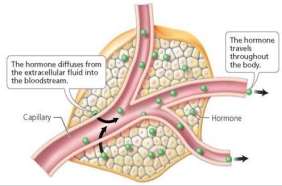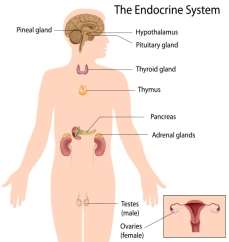Vocabulary and Key Definitions in the Human Body
| ✅ Paper Type: Free Essay | ✅ Subject: Physiology |
| ✅ Wordcount: 996 words | ✅ Published: 11 Sep 2017 |

The endocrine system works with the nervous system and circulatory system to regulate the body’s activities of cells, tissues, and organs. The nervous system triggers the endocrine system to contract the specific gland and secrete a specific hormone to keep the body in homeostasis. The hormones bind to a protein to hitch a ride using the circulatory system to transport the hormones to get to where they are going. The endocrine system uses what is called negative feedback.
Negative feedback works like this: when the body senses hormone A+ (positive) is over its limit, the body triggers hormone A- (negative) to start producing so the hormone balance is within a set limit or tells hormone A+ to stop producing that hormone for the time being. This reaction works both ways.
The only glands that do not use negative feedback are the reproductive glands, they are on a positive feedback system. Positive feedback means an action or stimulation occurs, the glands start producing hormones that stimulate a different hormone or action. Once the initial action or stimulation ceases, the gland stops producing the hormone or action.
Figure 2 (Browne, C., Dr.2016)
Word Parts:
-Crin – to secrete
Diuret – to pass urine
Endo – inside
Homeo – similar
Horm – impetus, impulse
Hypo – below
Lact milk
Para – beside
-Stasis – slow down or stop
Toc – birth
-Tropic – influencing
Key Terms:
Active Transport – movement of a substance through a cellular membrane that requires cellular energy.
Anterior –
Diffusion – movement from high to low concentrations, equaling out both sides.
Glucose – simple sugar that is required for energy within the body.
Homeostasis – internal environment staying the same on consistent.
Negative Feedback – System of slowing down to stopping process due to a specific input.
Osmosis – “diffusion of water through a selectively permeable membrane” (Bonewit-West, K., Hunt, S. A., & Applegate, E. J., 2016)
Passive Transport – moves substance through a membrane and does not require cellular energy.
Receptor Cell – cell that binds to a specific chemical or hormone.
Target Cell – has a specific receptor added to the cell that will only reaction with a specific chemical or hormone.
The Endocrine System

Figure 1 (Endocrine Gland, 2016)
How does it work?

Endocrinology – study of endocrine system
Hormone – chemical “that influence growth, development, and metabolic activates” (Bonewit-West, K., Hunt, S. A., & Applegate, E. J., 2016. p 187) Classified as either Proteins or Steroids. Except for sex hormones (classified as proteins or protein derivatives).
Endocrine Gland – (ductless glands) do not have ducts but secrete hormones directly into the bloodstream.
Pineal Gland -Aids in sleep. Secretes melatonin.
Hypothalamus – aids in “stimulating other endocrine glands to release hormones” (Shier, D., Butler, J., Lewis, R., & Shier, D., 1999 p 496). Secretes tropic hormones.
Pituitary Gland (The Master Gland) – Kickstarts adrenals glands into secreting specific hormones, regulates growth, metabolism, “balance of water” (Dowshen, S., MD, 2015), and body composition. This system is divided into anterior and posterior lobes. Anterior lobe secretes Growth Hormone (GH), Stimulations Hormone (TSH), Adrenocorticotropic Hormone (ACTH), Follicle-stimulations Hormone (FSH), Luteinizing Hormone (LH), and Prolactin (PRL). Posterior secrete Antidiuretic Hormone (ADH), and Oxytocin (OT). (Shier, D., Butler, J., Lewis, R., & Shier, D., 1999 p 497)
Thyroid Gland – Their function is to regulate the metabolism of carbohydrates, lipids, and proteins. Secretes thyroxine (T4) and triiodothyronine (T3). Parathyroid Gland – located behind the thyroid gland and regulates calcium and phosphate ions in the bloodstream. Secretes parathyroid hormone
Figure 3 (Endocrine Gland, 2016)
Thymus – Aids in immunity and formations of different white blood cells. Secretes thymosins.
Pancreas – Serves a dual purpose as a digestive organ and endocrine gland. Regulates blood sugar. Secretes glucagon, insulin, somatostatin,
Adrenal Gland – located on top of the kidneys. Helps regulate metabolism, body response to stress, and blood pressure. It secretes epinephrine, norepinephrine, cortisol, aldosterone (Sargis, R. M., MD, PHD, n.d.), androgens (male), and estrogens (female) (Shier, D., Butler, J., Lewis, R., & Shier, D., 1999 p 512)
Ovary (female) – Helps in the maturation of female. Secretes estrogen and progesterone.
Testis (male) – Helps in the maturation of male. Secretes testosterone.
Other glands – Lining of the stomach (not studied well) and small intestine (not studied well), heart (atrial natriuretic peptide), and kidneys (erythropoietin).
What does this all mean?
What happens is when a hormone is secreted into the bloodstream through osmosis or diffusion and it seeks out a specific “target cell”. Each cell, part of the body, gland, or type of organ had specific receptor cells. This target cell attaches to the receptor cell and tells the cell, part of the, body, gland, or type of organ what to do and/or what to release back into the blood stream. This attachment can be done through active to passive transport. The endocrine system affects the integumentary (skin), skeletal, muscular, nervous, cardiovascular (heart), lymphatic, digestive, respiratory (lungs), urinary, and reproductive systems.
What can go wrong?
Diabetes – bodies unable to store or use glucose. There are 6 different types of diabetic conditions: gestational (while pregnant), hyperglycemia (too much glucose in the blood), Hypoglycemia (not enough glucose in the blood), prediabetes (warning prior to full diabetes), Type 1 (no insulin production), Type 2 (lack absorption of insulin).
Growth disorders – the pituitary gland doesn’t produce enough somatotropin (growth hormone, aid in cell division) which doesn’t make children grow at a normal rate. This does not affect brain function, just height, weight, and in severe cases; muscle and skeletal mass.
These are just a few of the common endocrine disorders out of the many that are present in patients.
References
Bonewit-West, K., Hunt, S. A., & Applegate, E. J. (2016). Today’s medical assistant: clinical & administrative procedures. St. Louis, MO: Elsevier.
Browne, C., Dr. (2016, June 6). Advanced Vocabulary Study: Mastering Word Parts. Retrieved March 28, 2017, from https://www.linkedin.com/pulse/advanced-vocabulary-study-mastering-word-parts-dr-charles-browne
Dowshen, S., MD. (2015, July). Endocrine System. Retrieved March 28, 2017, from http://kidshealth.org/en/teens/endocrine.html
Endocrine Gland. (2016, September 11). Retrieved March 28, 2017, from http://cephalicvein.com/2016/07/endocrine-gland/
Sargis, R. M., MD, PHD. (n.d.). An Overview of the Adrenal Glands. Retrieved March 28, 2017, from https://www.endocrineweb.com/endocrinology/overview-adrenal-glands
Shier, D., Butler, J., Lewis, R., & Shier, D. (1999). Hole’s human anatomy & physiology. Boston, MA: WCB/McGraw-Hill.
Cite This Work
To export a reference to this article please select a referencing stye below:
Related Services
View allDMCA / Removal Request
If you are the original writer of this essay and no longer wish to have your work published on UKEssays.com then please click the following link to email our support team:
Request essay removal


